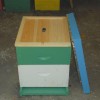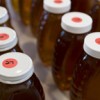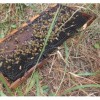 The predominant material used to construct honey bee colonies in the U.S. is wood. Though honey bee hive components are simple in design, they are subjected to many extreme management techniques that cause wear and tear, ultimately shortening the life of the equipment. This article discusses how to protect colony woodenware, particularly the pieces that are exposed to the elements. These include the bottom board, hive body/supers, and lids. This 4-page fact sheet was written by J. D. Ellis, W. H. Kern, and C. M. Zettel Nalen, and published by the UF Department of Entomology and Nematology, June 2012.
The predominant material used to construct honey bee colonies in the U.S. is wood. Though honey bee hive components are simple in design, they are subjected to many extreme management techniques that cause wear and tear, ultimately shortening the life of the equipment. This article discusses how to protect colony woodenware, particularly the pieces that are exposed to the elements. These include the bottom board, hive body/supers, and lids. This 4-page fact sheet was written by J. D. Ellis, W. H. Kern, and C. M. Zettel Nalen, and published by the UF Department of Entomology and Nematology, June 2012.
http://edis.ifas.ufl.edu/aa244
Tag: J. D. Ellis
Bottling, Labeling and Selling Honey in Florida (ENY159/IN918)
 In 2011, the Florida Legislature enacted HB 7209 allowing individuals to manufacture, sell, and store certain types of “cottage foods”(including honey) in an unlicensed kitchen. “Cottage food operations,” as they are called, require no licensing or permitting from the Florida Department of Agriculture and Consumer Services and are not inspected by any other state government entity. This 4-page fact sheet was written by Nancy Gentry and James D. Ellis, and published by the UF Department of Entomology and Nematology, August 2012.
In 2011, the Florida Legislature enacted HB 7209 allowing individuals to manufacture, sell, and store certain types of “cottage foods”(including honey) in an unlicensed kitchen. “Cottage food operations,” as they are called, require no licensing or permitting from the Florida Department of Agriculture and Consumer Services and are not inspected by any other state government entity. This 4-page fact sheet was written by Nancy Gentry and James D. Ellis, and published by the UF Department of Entomology and Nematology, August 2012.
http://edis.ifas.ufl.edu/in918
Florida Bears and Beekeeping (ENY105/AA133)
 The Florida black bear (Ursus americanus floridanus) is a minor predator of beehives in Florida with the potential to cause major destruction. Large-scale urban and agricultural development inexorably reduces prime bear habitat each year. This habitat also contains excellent bee forage, and so bears and bees will sometimes come in contact, thus resulting in bear predation. This 4-page fact sheet was written by Malcolm T. Sanford and James D. Ellis, and published by the UF Department of Entomology and Nematology, August 2012.
The Florida black bear (Ursus americanus floridanus) is a minor predator of beehives in Florida with the potential to cause major destruction. Large-scale urban and agricultural development inexorably reduces prime bear habitat each year. This habitat also contains excellent bee forage, and so bears and bees will sometimes come in contact, thus resulting in bear predation. This 4-page fact sheet was written by Malcolm T. Sanford and James D. Ellis, and published by the UF Department of Entomology and Nematology, August 2012.
http://edis.ifas.ufl.edu/aa133
Cape Honey Bee Apis mellifera capensis Escholtz (EENY513/IN916)
 Cape honey bees can produce both male and female offspring parthenogenetically. Unlike other African bee races, they are docile, but unlike all other races of honey bees, they are social parasites. Find out why South African beekeepers consider Cape bees a more serious threat than the varroa mite in this 4-page fact sheet was written by James D. Ellis, and published by the UF Department of Entomology and Nematology, December 2011.
Cape honey bees can produce both male and female offspring parthenogenetically. Unlike other African bee races, they are docile, but unlike all other races of honey bees, they are social parasites. Find out why South African beekeepers consider Cape bees a more serious threat than the varroa mite in this 4-page fact sheet was written by James D. Ellis, and published by the UF Department of Entomology and Nematology, December 2011.
http://edis.ifas.ufl.edu/in916
Miner Bee, Chimney Bee Anthophora abrupta Say (EENY512/IN912)
 These gregarious, yet solitary, ground-nesting bees are “…conspicuous as they noisily swing their ponderous bodies to and fro on the wing, arrive home and scramble into their burrows or come tumbling out headlong and dash off into the sunny fields, with all the exuberance of boys just out of school.” This 5-page fact sheet was written by Jason R. Graham, Jamie Ellis, Glenn Hall, and Catherine Zettel Nalen, and published by the UF Department of Entomology and Nematology, December 2011.
These gregarious, yet solitary, ground-nesting bees are “…conspicuous as they noisily swing their ponderous bodies to and fro on the wing, arrive home and scramble into their burrows or come tumbling out headlong and dash off into the sunny fields, with all the exuberance of boys just out of school.” This 5-page fact sheet was written by Jason R. Graham, Jamie Ellis, Glenn Hall, and Catherine Zettel Nalen, and published by the UF Department of Entomology and Nematology, December 2011.
http://edis.ifas.ufl.edu/in912
Sweat Bees, Halictid Bees, Halictidae (Insecta: Hymenoptera: Halictidae) (EENY499/IN897)
 Sweat bees are very important pollinators for many wildflowers and crops, including stone fruits, pomme fruits, alfalfa and sunflower. Sweat bee populations can be encouraged with wildflower plantings and by providing nesting areas. Halictids typically nest in bare soil located in a sunny location. Minimum tillage and insecticide use will help to increase populations of Halictidae and other soil nesting bees. Learn more about this diverse family of bees in this 5-page fact sheet was written by Katie Buckley, Catherine Zettel Nalen, and Jamie Ellis, and published by the UF Department of Entomology and Nematology, August 2011.
Sweat bees are very important pollinators for many wildflowers and crops, including stone fruits, pomme fruits, alfalfa and sunflower. Sweat bee populations can be encouraged with wildflower plantings and by providing nesting areas. Halictids typically nest in bare soil located in a sunny location. Minimum tillage and insecticide use will help to increase populations of Halictidae and other soil nesting bees. Learn more about this diverse family of bees in this 5-page fact sheet was written by Katie Buckley, Catherine Zettel Nalen, and Jamie Ellis, and published by the UF Department of Entomology and Nematology, August 2011.
http://edis.ifas.ufl.edu/in897
ENY158/IN874 Explaining the Best Management Practices for Maintaining European Honey Bee Colonies
ENY158, a 4-page fact sheet by M. K. O’Malley, J.D. Ellis and G. W. Hayes, Jr., outlines and explains the 12 recommendations listed in the voluntary agreement between Florida beekeepers and state officials to minimize the spread of African honey bees. Published by the UF Department of Entomology and Nematology, October 2010.
http://edis.ifas.ufl.edu/in874
ENY157/IN872 Theft, Vandalism, and Other Related Crime in the Beekeeping Industry: A Guide for Beekeepers
ENY157, a 2-page fact sheet by C.M. Zettel Nalen and J.D. Ellis, provides recommendations for crime prevention in beekeeping operations, what to do if hives or equipment are stolen or vandalized, and resources for beekeepers. Published by the UF Department of Entomology and Nematology, September 2010.
http://edis.ifas.ufl.edu/in872
ENY152/IN868 The Benefits of Pollen to Honey Bees
ENY152, a 4-page illustrated fact sheet by Amanda Ellis, Jamie Ellis, Michael O’Malley and Catherine Zettel Nalen, provides an overview of the nutritional needs of honey bees with an emphasis on the role of pollen — nutritional content, where it is produced, how it is collected, and how to ensure colony nutrition. Published by the UF Department of Entomology and Nematology, September 2010.
http://edis.ifas.ufl.edu/in868
ENY141S/IN864 Cómo Lidiar con Abejas Africanas: Una Guía Práctica
ENY141S, a 4-page fact sheet by M. K. O’Malley, J. D. Ellis, Pablo Herrera and A. S. Neal, is the Spanish language version of ENY-141/IN739 What to do about African Honey Bees: A Consumer Guide. It provides information about Africanized honey bees (AHB), which have been labeled ”killer” bees, steps people can take to avoid negative interactions, how to handle stings, and bee-proofing basics. Published by the UF Department of Entomology and Nematology, August 2010.
http://edis.ifas.ufl.edu/in864
ENY140S/IN862 Preguntas Frecuentes Acerca de la Abeja Melífera Africanizada en Florida
ENY-140S, a 3-page fact sheet by M. K. O’Malley, J. D. Ellis, P. Herrera and A. S. Neal, is the Spanish language version of ENY140/IN738 Frequently Asked Questions about the Africanized Honey Bee in Florida. It provides information about Africanized honey bees (AHB) in a question-and-answer format. Published by the UF Department of Entomology and Nematology, August 2010.
http://edis.ufl.edu/in862
ENY150/IN720: Colony Collapse Disorder (CCD) in Honey Bees
Revised! ENY-150, a 5-page illustrated fact sheet by Jamie Ellis, explains what is known about about this problem threatening the beekeeping industry in the U.S. — its symptoms, theories about its cause, how it affects the general public, what’s being done, and management recommendations for beekeepers. Includes selected references. Published by the UF Department of Entomology and Nematology, July 2010.
http://edis.ifas.ufl.edu/in720
EENY473/IN855 Varroa Mite, Varroa destructor Anderson and Trueman (Arachnida: Acari:Varroidae)
EENY473, an 8-page illustrated fact sheet by James D. Ellis and C. M. Zettel Nalen, is part of the Featured Creatures collection. It describes this devastating pest of Western honey bees — distribution, description, life cycle, economic importance, detection, and management. Includes references. Published by the UF Department of Entomology and Nematology, June 2010.
http://edis.ifas.ufl.edu/in855
EENY474/IN854 Small Hive Beetle, Aethina tumida Murray (Insecta: Coleoptera: Nitidulidae)
EENY474, a 5-page illustrated fact sheet by James D. Ellis and Amanda Ellis, is part of the Featured Creatures collection. It describes this small beetle native to sub-Saharan Africa, which can cause considerable damage to colonies of European honey bees outside of its host range — distribution, description, life cycle, economic importance, and management. Includes references. Published by the UF Department of Entomology and Nematology, June 2010.
http://edis.ifas.ufl.edu/in854
ENY156/IN848 Florida Beekeeping Management Calendar
ENY156, a 7-page fact sheet by J.D. Ellis and C.M. Zettel Nalen, provides Florida beekeepers a reference for honey bee colony management with specific guidance for region by month, including recommendations for major management considerations and blooming plants. Includes reference. Published by the UF Department of Entomology and Nematology, May 2010.
http://edis.ifas.ufl.edu/in848
ENY155/IN847 Florida Master Beekeeper Program Requirements
ENY155, a 9-page fact sheet by James Ellis, Jerry Hayes, Catherine Zettel Nalen, William H. Kern, Ray Zerba, and Brad Burbaugh, describes the requirements for this beekeeper training and certification program provided by the University of Florida. Published by the UF Department of Entomology and Nematology, May 2010.
http://edis.ifas.ufl.edu/in847
EENY472/IN845 Bee louse, bee fly, braulid, Braula coeca Nitzsch (Insecta: Diptera: Braulidae)
EENY472, a 3-page illustrated fact sheet by James D. Ellis and C.M. Zettel Nalen, is part of the Featured Creatures collection. It describes this wingless fly that lives as a commensalist in western honeybee colonies — distribution, description, life cycle and behavior and management. Includes references. Published by the UF Department of Entomology and Nematology, April 2010.
http://edis.ifas.ufl.edu/in845
ENY128/AA142 Infant Botulism and Honey
Revised! ENY128, a 2-page fact sheet by Malcolm T. Sanford, Eddie Atkinson and Jamie Ellis, prepares beekeepers to answer questions responsibly about honey as a potential source of C. botulinum spores, which can cause botulism in infants under 12 months of age. Includes references. Published by the UF Department of Entomology and Nematology, October 2009.
http://edis.ifas.ufl.edu/AA142
ENY147/IN784 Differences Between European and African Honey Bees
ENY147, a 3-page illustrated fact sheet by M. K. O’Malley, J. D. Ellis and C. M. Zettel Nalen, describes key differences between the agressive African bee and the docile European honey bee, including hive defense and stinging, swarming and absconding, selection of nesting site. Includes references. Published by the UF Department of Entomology and Nematology, October 2009.
http://edis.ifas.ufl.edu/IN784
ENY748/IN785 Swarm Trapping for Pest Control Operators
ENY748, a 6-page illustrated fact sheet by M. K. O’Malley, J. D. Ellis and C. M. Zettel Nalen, outlines the standard operating procedures for swarm trapping by certified Pest Control Operators as a means of capturing and removing a nesting Africanized bee colony before the bees become aggressive. Published by the UF Department of Entomology and Nematology, October 2009.
http://edis.ifas.ufl.edu/IN785